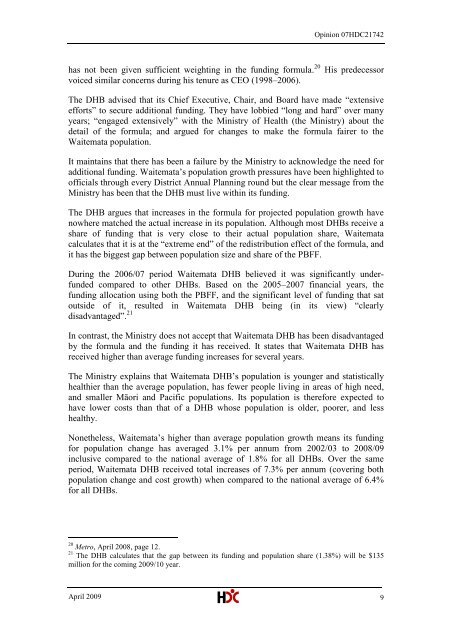North Shore Hospital report - New Zealand Doctor
North Shore Hospital report - New Zealand Doctor
North Shore Hospital report - New Zealand Doctor
You also want an ePaper? Increase the reach of your titles
YUMPU automatically turns print PDFs into web optimized ePapers that Google loves.
Opinion 07HDC21742has not been given sufficient weighting in the funding formula. 20 His predecessorvoiced similar concerns during his tenure as CEO (1998–2006).The DHB advised that its Chief Executive, Chair, and Board have made ―extensiveefforts‖ to secure additional funding. They have lobbied ―long and hard‖ over manyyears; ―engaged extensively‖ with the Ministry of Health (the Ministry) about thedetail of the formula; and argued for changes to make the formula fairer to theWaitemata population.It maintains that there has been a failure by the Ministry to acknowledge the need foradditional funding. Waitemata‘s population growth pressures have been highlighted toofficials through every District Annual Planning round but the clear message from theMinistry has been that the DHB must live within its funding.The DHB argues that increases in the formula for projected population growth havenowhere matched the actual increase in its population. Although most DHBs receive ashare of funding that is very close to their actual population share, Waitematacalculates that it is at the ―extreme end‖ of the redistribution effect of the formula, andit has the biggest gap between population size and share of the PBFF.During the 2006/07 period Waitemata DHB believed it was significantly underfundedcompared to other DHBs. Based on the 2005–2007 financial years, thefunding allocation using both the PBFF, and the significant level of funding that satoutside of it, resulted in Waitemata DHB being (in its view) ―clearlydisadvantaged‖. 21In contrast, the Ministry does not accept that Waitemata DHB has been disadvantagedby the formula and the funding it has received. It states that Waitemata DHB hasreceived higher than average funding increases for several years.The Ministry explains that Waitemata DHB‘s population is younger and statisticallyhealthier than the average population, has fewer people living in areas of high need,and smaller Māori and Pacific populations. Its population is therefore expected tohave lower costs than that of a DHB whose population is older, poorer, and lesshealthy.Nonetheless, Waitemata‘s higher than average population growth means its fundingfor population change has averaged 3.1% per annum from 2002/03 to 2008/09inclusive compared to the national average of 1.8% for all DHBs. Over the sameperiod, Waitemata DHB received total increases of 7.3% per annum (covering bothpopulation change and cost growth) when compared to the national average of 6.4%for all DHBs.20 Metro, April 2008, page 12.21 The DHB calculates that the gap between its funding and population share (1.38%) will be $135million for the coming 2009/10 year.April 2009 9
















